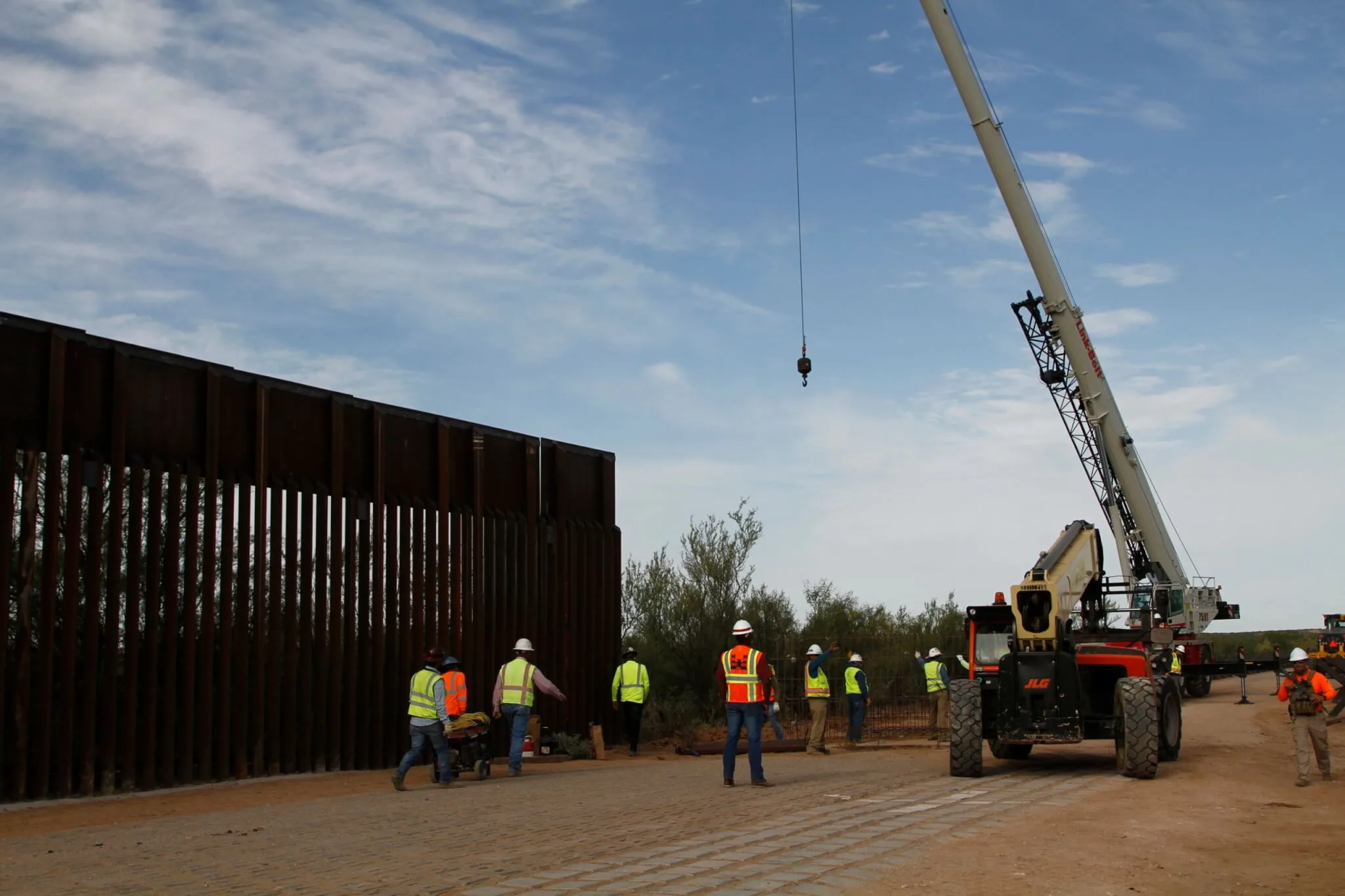
FILE - In this Aug. 23, 2019 file photo, workers break ground on new border wall construction about 20 miles west of Santa Teresa, N.M. Construction on a Pentagon-funded portion of the border wall began near Yuma, Arizona, this week, just as federal authorities announced they are diverting even more defense funds for wall projects. Crews began constructing a 30-foot steel fence along the Colorado River this week. (AP Photo/Cedar Attanasio, File)
The proposal would divert $2.5 billion of the Defense Department’s budget to border wall construction.
The White House has been blocked by lower courts for attempting to use military funds to construct a wall at the US-Mexico border.
The Supreme Court said Monday it will consider whether the Trump administration can use an emergency declaration to divert $2.5 billion on Defense Department funds to construct the southern border wall.
Two lower courts have rejected the administration’s argument, agreeing with opponents who argue that the emergency declaration was meant to bypass Congress and is unconstitutional, rulings the administration is challenging.
Both sides welcomed Monday’s announcement that the high court would hear the case.
RELATED: Steve Bannon Arrested for Fraudulent ‘We Build the Wall’ Campaign
“This gives us a chance to go to the highest court of the land and tell them why transferring this money was unlawful, as the other courts have said, but also to talk about the reasons why a border wall is so harmful for our communities,” said Vicki Gaubeca, director of the Southern Border Communities Coalition, one of two groups that sued to block the wall funding
But Rep. Paul Gosar, R-Prescott, defended the funding shift, saying in a statement Monday that “protecting the border and our national sovereignty is a core and fundamental purpose of the military.”
“The allocation of Defense money to defend the national borders is 100% constitutional and consistent with congressional intent,” Gosar said. “The American people need and deserve a secure border. They’re getting one from this administration.
No date has been set for a hearing on the case, but the court’s calendar is already full through the end of this year. But it will not be the first time the high court has considered the issue: The Supreme Court previously blocked the lower courts’ orders, allowing wall construction to proceed while the case worked its way through the courts.
The dispute over border wall funding began in late 2018, when Congress refused to give Trump billions for border wall construction and he refused to sign the budget, a standoff that led to a 45-day partial government shutdown.
The shutdown ended in February 2019, when Congress agreed to allocate $1.375 billion for limited border wall projects. But immediately after signing that budget, Trump declared a national emergency at the border that he said authorized the transfer of up to $8.1 billion from other government sources to fund border wall projects.
RELATED: Trump’s Wall Construction Will Continue, SCOTUS Tells Environmental Groups Fighting to Preserve Species and Land
The Southern Border Communities Coalition and the Sierra Club quickly filed suit, claiming Trump’s use of emergency powers was an unconstitutional attempt to bypass Congress.
A federal district court agreed and in June 2020 a divided panel of the 9th U.S. Circuit Court of Appeals upheld the lower court’s ruling that transferring $2.5 billion in Defense Department funds originally budgeted for military pay and pensions was unlawful.
“We all learned in our basic civics education that Congress has the power of the purse, and that is definitely something that the administration has not acknowledged,” said Sandy Bahr, director of the Sierra Club Grand Canyon Chapter.
Even though Congress set a specific limit on wall funding, the administration said, “‘OK, well, we’ll just take this money and do it anyway,’” Bahr said. “That is contrary to the separation of powers outlined in the U.S. Constitution.”
But Ira Mehlman, media director for the Federation for American Immigration Reform, said the money is being used properly, as the Pentagon funds would be used for border protection.
“It’s not like they’re pulling this out of the Education Department or the Commerce Department’s budget,” Mehlman said. “This is legitimately going to be used for … the security of the country, because when you have borders that are open, it’s not just people who are coming here to work illegally, but potentially people who are coming here to do harm to this country.”
While conservation groups have criticized the wall’s environmental impact, saying it will disrupt threatened ecosystems and that construction will harm endangered species, Mehlman argues the opposite. He said that migrants crossing the border have a greater impact on the environment than construction crews do or a wall would.
Bahr calls that argument a “distraction from the real harm that is being done” by the wall: “Harm to the Constitution, the harm to the lands, to our waters, to communities, to people to wildlife to sacred areas, important for cultural values.”
The Supreme Court also said Monday that it will hear the Trump administration’s defense of its Migrant Protection Protocols, a policy that requires asylum-seekers at the southern border to wait in Mexico while their cases are pending. The 9th Circuit had blocked the “remain in Mexico” policy.
Gaubeca said she hopes the two cases start a conversation on what borders should look like.
“There is a need to rethink borders to create a new, more welcoming border,” she said. “We’re hopeful that both of these cases will start speaking to that new border governance model that we have been aspiring to for a while now.”
Continue Reading: Trump’s Border Wall Leaves Mountains Blasted and Saguaros Uprooted

He said what? 10 things to know about RFK Jr.
The Kennedy family has long been considered “Democratic royalty.” But Robert F. Kennedy, Jr.—son of Robert F. Kennedy, who was assassinated while...

Here’s everything you need to know about this month’s Mercury retrograde
Does everything in your life feel a little more chaotic than usual? Or do you feel like misunderstandings are cropping up more frequently than they...

Arizona expects to be back at the center of election attacks. Its officials are going on offense
Republican Richer and Democrat Fontes are taking more aggressive steps than ever to rebuild trust with voters, knock down disinformation, and...

George Santos’ former treasurer running attack ads in Arizona with Dem-sounding PAC name
An unregistered, Republican-run political action committee from Texas with a deceptively Democratic name and ties to disgraced US Rep. George Santos...




